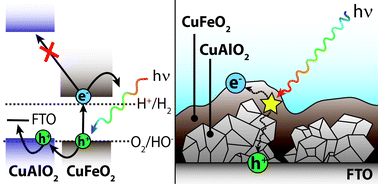Improving charge collection with delafossite photocathodes: a host–guest CuAlO2/CuFeO2 approach†
Abstract
p-Type delafossite CuFeO2 has recently been reported as a promising candidate for direct photoelectrochemical solar water reduction in alkaline conditions. However, despite its favorable optical band gap energy and light absorption, this material suffers from poor electron–hole separation that limits its optimum thickness to a few hundred nanometers. This limitation can be addressed by a host–guest strategy, where a mesoporous p-type scaffold is used to support a thin-film of the light absorber. Here we demonstrate this host–guest approach for the first time with CuFeO2 using p-type transparent CuAlO2 as a scaffold. Optimizing the scaffold layer thickness at 2 μm resulted in a 2.4-fold increase in photocurrent in the presence of O2—a sacrificial electron scavenger—reaching 2.4 mA cm−2 at +0.4 V vs. RHE. Moreover, comparing the performance to host–guest electrodes prepared with an insulating SiO2 scaffold as a control suggested that the observed improvement with CuAlO2 was due to a decreased recombination stemming from improved charge separation in addition to improved charge transport through the scaffold compared to the CuFeO2 film alone.

- This article is part of the themed collection: Water splitting and photocatalysis

 Please wait while we load your content...
Please wait while we load your content...